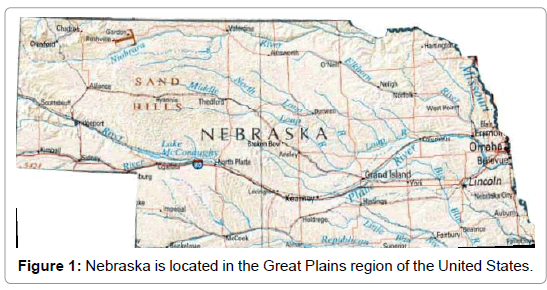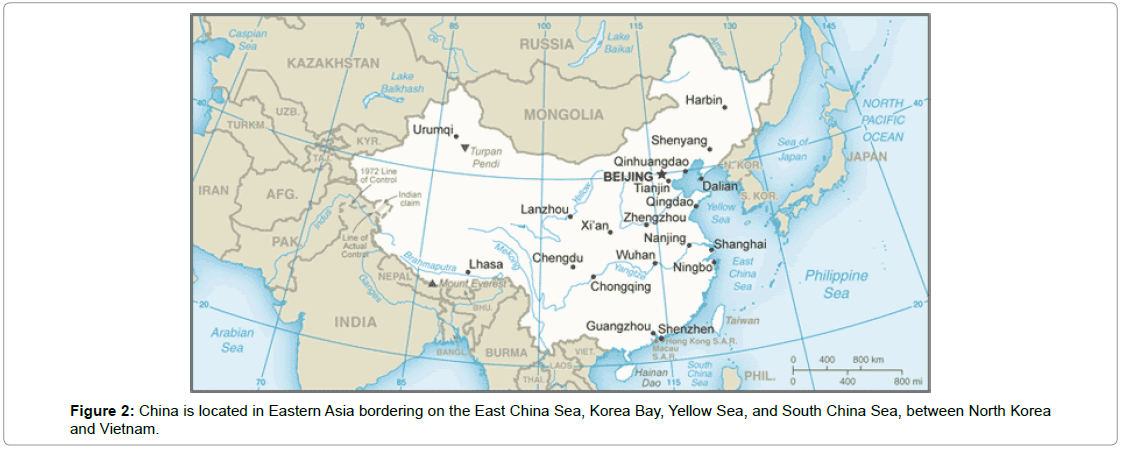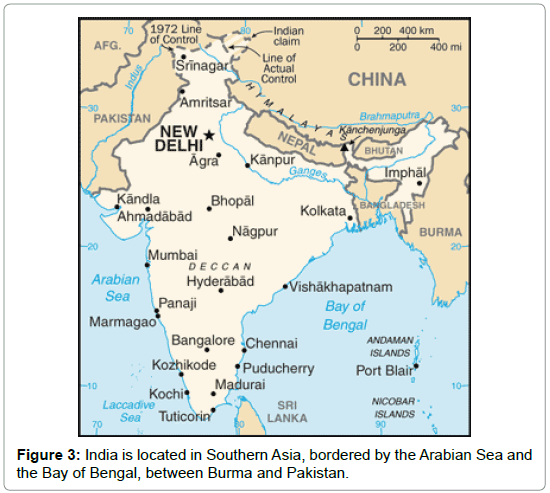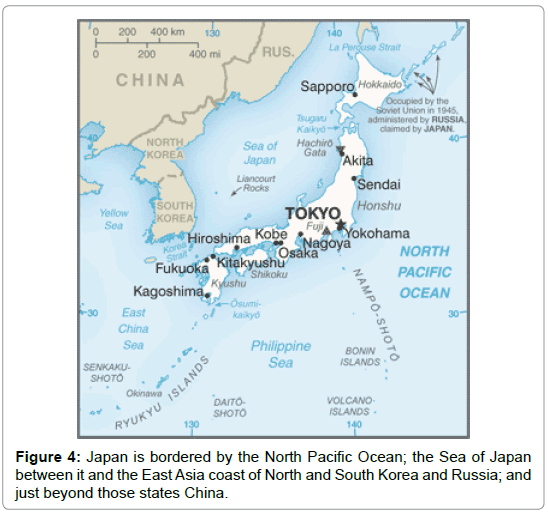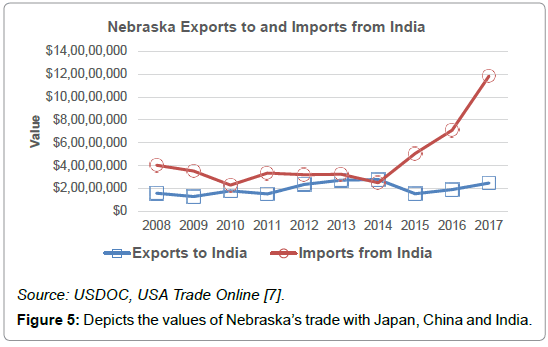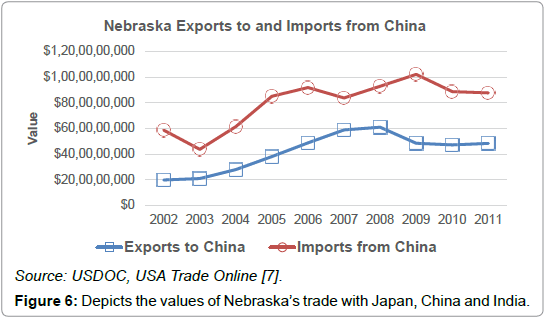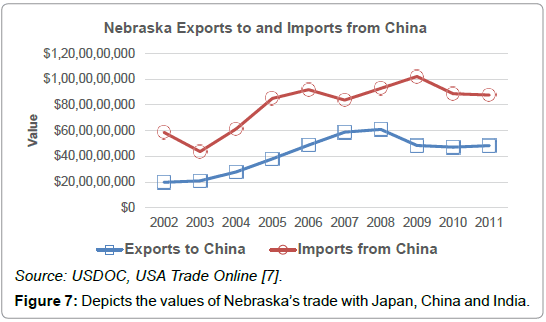Research Article, Res J Econ Vol: 2 Issue: 3
An Intra-Industry Analysis Of Nebraska’s Trade With Japan, India, And China, 2002-2017
Kotcherlakota VV* and Lundeen M
Nebraska Department of Economic Development, Lincoln, NE, United States
*Corresponding Author : Vani V Kotcherlakota
Research Division, NEDED, P.O. Box 94666, Lincoln, NE, United States
Tel: (402) 471-3116
E-mail: Vani.Kotcherlakota@Nebraska.gov
Received: April 23, 2018 Accepted: May 09, 2018 Published: May 16, 2018
Citation: Kotcherlakota VV, Lundeen M (2018) An Intra-Industry Analysis of Nebraska’s Trade with Japan, India, and China, 2002-2017. Res J Econ 2:3.
Abstract
The main objective of the paper is to analyze Nebraska’s trade with Japan, India, and China by estimating growth rates and making intra-industry trade estimates for the period 2002-2017. The principal findings from the study are that Nebraska’s trade with China, India, and Japan has grown at different rates and is more inter-industry than intra-industry. The study uses data from the Department of Commerce’s USA Online for this analysis. There are some inherent problems with that data that limit this study’s conclusions. Thus, this study is essentially exploratory and requires a deeper analysis with more extended data.
Keywords: Trade; Growth rates; Intra-industry trade
Introduction
The main objective of the paper is to present a comparative analysis of Nebraska’s trade with Japan, India, and China and to provide intra-industry trade estimates for select products for the period 2002-2017. The paper includes four sections. Section 1 consists of brief demographic profiles of Japan, India, China, and Nebraska. The second section focuses on data and methodology. An analysis of Nebraska’s trade with Japan, China, and India constitutes the third section. The final section presents intra-industry trade estimates for selected commodities.
Section 1: Profiles of Nebraska, Japan, China, and India
Nebraska is located in the Great Plains region of the United States (Figure 1). Agriculture has been the cornerstone of its economy from the beginning because of its rich soil and water resources. Its nickname is the Cornhusker Sate because corn production constitutes the largest portion of its agricultural crop production. There is great demand for corn ethanol; hence corn production has been increasing in recent years. A solid manufacturing sector complements Nebraska’s strength in agricultural production – food processing, farm equipment, chemicals production, and instruments are the top manufacturing industries in the state. Another economic strength for the state is the transportation industry. Nebraska is the home to the world’s largest train yard – the Bailey Yard in North Platte – and home to the headquarters of Union Pacific railroad, as well as home to several large trucking companies.
Nebraska’s main export partners are Mexico, Canada, Japan, China, South Korea, Australia, Hong Kong, Belgium, Germany, and the Netherlands. The top ten countries that Nebraska imports from are China, Canada, Germany, Mexico, Japan, United Kingdom, Austria, Switzerland, France, and India. Nebraska’s main exports are meat; industrial machinery; cereals; hides & leather; animal feeds; oil seeds; electrical machinery; precision instruments; pharmaceuticals; and chemicals. The main commodities imported are industrial machinery; organic chemicals; electrical machinery; motor vehicles & parts; pharmaceuticals; precision instruments; furniture, toys; sports equipment; and plastics (Table 1).
| Variable | Value |
|---|---|
| Population | 1,920,076 |
| Ages 0-19 | 27.5% |
| Ages 19-24 | 57.9% |
| Ages 65+ | 14.6% |
| Persons 65 years and above | 15.0% |
| Total Employment | 870,279 |
| Land Area | 76,824 sq mi |
| Water – % of land area | 0.68% |
| GDP (2016) | $117,446 million |
| Total Exports | $6,369,969,992 |
| Total Imports | $3,559,973,645 |
| Unemployment rate | 3.2% (2016) |
| Aver Annual per capita income | $49,636 |
| Economic Growth | 1.7% |
| % of pop. below poverty level | 11.0% |
Table 1: Nebraska Demographic Profile.
There has been great change in China since 1978 – the focus is now on market-oriented economic development. Between 1978 and 2000, output quadrupled and overall living standards improved dramatically. But political control of the economy remains tight. China is located in Eastern Asia bordering on the East China Sea, Korea Bay, Yellow Sea, and South China Sea, between North Korea and Vietnam (Figure 2). The government’s 13th Five Year Plan was unveiled in March 2016. The emphasis is on the need to increase innovation and boost domestic consumption so that the economy is less dependent on government investment, exports, and heavy industry.
The main commodities that are exported are electrical and other machinery, including computers and telecommunications equipment, apparel, furniture, and textiles. Its main exporting partners are the USA 18.2%, Hong Kong 13.8%, Japan 6.1%, and South Korea 4.5%. The main commodities imported by China are electrical and other machinery, including computers, integrated circuits and other computer components, oil and mineral fuels; optical and medical equipment, metal ores, motor vehicles and soybeans. Its main importing partners are South Korea 10.0%, Japan 9.2%, USA 8.5%, Germany 5.4%, and Australia 4.4%.
India is located in Southern Asia, bordered by the Arabian Sea and the Bay of Bengal, between Burma and Pakistan (Figure 3). It became independent from the British rule in 1947. It has 29 states and 7 Union Territories. India’s economy is diverse, including traditional village farming, modern agriculture, handicrafts, a wide range of modern industries, and a multitude of services. Despite several problems, such as significant overpopulation, environmental degradation, extensive poverty, and widespread corruption, two factors are driving India’s emergence as a regional and global power – the 1991 launching of economic reforms and a comparatively young population. India is developing into an open market economy. The country’s growth averaged nearly seven percent per year from 1997-2017. However, in 2011, the growth slowed due to a decline in investment caused by high interest rates, rising inflation, investor pessimism, and slow world growth. The positive economic factors for India are a young population, a low dependency ratio, healthy savings and investment rates, and increasing integration into the global economy. Factors that hinder growth in India are: discrimination against women and girls, an inefficient power generation and distribution system, ineffective enforcement of intellectual property rights, decades long civil litigation dockets, inadequate transport and agricultural infrastructure, limited nonagricultural employment opportunities, high spending and poorly targeted subsidies, inadequate availability of quality basic and higher education, and accommodating a rural to urban-migration.
India’s major mineral resources include coal, iron ore, mica, bauxite, chromite, natural gas, diamonds, limestone, and thorium. The main agricultural products are wheat, oilseed, cotton, jute, tea, sugarcane, lentils, onions, potatoes, dairy products, sheep, goats, poultry, and fish. The main industries are textiles, chemicals, food processing, steel, transportation equipment, cement, mining, petroleum, machinery, and software. The main commodities exported by India are petroleum products, precious stones, vehicles, machinery, iron and steel, chemicals, pharmaceutical products, cereals, and apparel. Its export partners are USA 16.0%, UAE 11.7%, and Hong Kong 5.1%. Crude oil, precious stones, machinery, chemicals, fertilizer, plastics, and iron and steel constitute the primary imports. India imports from China 17.0%, USA 5.8%, UAE 5.4%, Saudi Arabia 5.2% and Switzerland 4.2%.
Japan is bordered by the North Pacific Ocean; the Sea of Japan between it and the East Asia coast of North and South Korea and Russia; and just beyond those states China (Figure 4). Japan’s economy has been mired, for at least ten years, in an economic slump -- nothing the Japanese central bank tries seems to stimulate economic growth. Part of the problem is that Japan has an aging population. It is so bad Japan had a negative population growth rate in 2016 – either more people are dying than are being born or more people are leaving Japan than are moving to Japan or both if this population loss is true (Table 2).
| Variable | China | India | Japan |
|---|---|---|---|
| Total Area | 9,596,960 sq. km | 3,287,263 sq. km | 377,915 sq. km |
| Land | 9,326,410 sq. km | 2,973,193 sq. km | 364,485 sq. km |
| Water | 270,500 sq. km | 314,070 sq. km | 13,340 sq. km |
| Population | 1,379,302,771* | 1,281,935,911 | 126,451,398 |
| 0-14 years | 17.15% | 27.34% | 12.84% |
| 15-24 years | 12.78% | 17.9% | 9.64% |
| 25-54 years | 48.51% | 41.08% | 37.5% |
| 55-64 years | 10.75% | 7.45% | 12.15% |
| 65 years and over | 10.81% | 6.24% | 57.87% |
| Population Growth Rate | 0.41% | 1.17% | -0.21% |
| GDP | 23.12 trillion* | $9.447 trillion* | $4.884 (trillion) |
| GDP real growth rate: | 6.8%* | 6.7%* | 1.5% |
| GDP per capita | $16,600* | $7,200* | $42,700 |
| GDP by end use | |||
| Household consumption | 38.0% | 58.7% | 55.9% |
| Government consumption | 14.6% | 11.6% | 19.5% |
| Investment in inventories | 1.1% | 4.0% | 0.2% |
| Exports of goods & services | 19.6% | 18.4% | 17.8% |
| Imports of goods & services | -17.7* | -20.2%* | -16.8% |
| GDP by sector of origin | |||
| Agriculture | -8.2% | 16.8% | 1.0% |
| Industry | 39.5% | 28.9% | 29.7% |
| Services | 52.5%* | 46.6%* | 69.3% |
| Labor force by occupation | |||
| Agriculture | 28.3% | 47.0% | 2.9% |
| Industry | 29.3% | 22.0% | 26.2% |
| Services | 42.4% | 31.0% | 70.9% |
| Unemployment rate | 4.0%* | 8.8%* | 2.9% |
| Population below poverty line | 3.30% | 21.90% | 16.1% |
| Revenues | $2.672 trillion | $248.7 billion | $1.678 trillion |
| Expenditures | $3.146 trillion* | $330.3 billion* | $1.902 trillion |
| Taxes & other revenues | 22.4% GDP | 10.2% GDP* | 34.3% of GDP |
| Public Debt | 18.6% GDP | 50.1% of GDP* | 223.8% of GDP |
| Inflation Rate | 1.8%* | 3.8%* | 0.4% (2017 est.) |
Table 2: Demographic and Economic Comparisons of China, India, & Japan.
China and India have similarly large populations (Table 2). However, in terms of land area, China is almost three times larger than India. Japan comes in a distant third to India and China that category. The population growth rate is higher for India (1.2%) than China (41%). Only in the category of 0-14 year-olds does India (27.34%) exceed that of China (17.2%) in percentage terms. As noted above, Japan’s overall population growth rate is negative (-0.21%) and an abnormally large percentage of Japan’s population is 65 years old and older -57.9% compared to 10.8% for China and 6.2% for India.
China’s GDP and GDP per capita are more than twice that of India. Japan’s per capita GDP out distances both China’s and India’s per capita GDP’s, but Japan comes in third in GDP growth rate, again, in part, because of its aging population. Household consumption contributes more to GDP in India than China whereas, for Government consumption and Investment in Inventories, the contributions are higher in China than in India. China has a balance of trade surplus and India has a balance of trade deficit. In both countries, the contributions to GDP by Service and industry sectors are higher than the agricultural sector. Unemployment and inflation rates are higher for India (8.8%; 3.8%) than for China (4.0%; 1.8%) or Japan (2.9%; 0.4%).
Section 2: Review of literature, data, and methodology
The main objective of this paper is to analyze the trade of Japan, China, and India with Nebraska.
Review of Literature
Jing et al. [1] study the extent and determinants of intra industry trade (IIT) in agricultural product of China for the period 1997- 2006. Their finding is that the IIT index shows that the level of IIT in agricultural products between China and its thirteen main trading partners is not high. The empirical results show that differences in per capita income and geographical distance have a negative effect on China’s IIT in agricultural products. A positive influence on this type of trade is observed when there is cultural similarity between China and some countries.
Marukawa et al. [2] examines the bilateral trade between China and Japan from 1972 to the present. His findings are that the bilateral trade has evolved from inter industry trade (in which China exported primary goods and Japan exported machinery) to intra industry trade (in which both sides mainly exported machinery to the other). The author also points out that China has caught up with (and now surpassed) Japan as an economic power. The analysis in this article is that up to 1993, most of the trade disputes involved Japan’s exports to china and were raised by the Chinese side. However, since 1994 most trade disputes were over Japan’s imports from China and were raised by the Chinese side.
Arip et al. [3] in their paper investigate the bilateral trade pattern between Japan, Malaysia, and China using the intra industry trade (IIT) index analysis. Their results indicate that China shows a higher degree of IIT relation with Japan vis-à-vis Malaysia. Another finding of theirs is that compared to Malaysia, China is rapidly increasing its export share in horizontally differentiated products or similar market segments.
Xing et al. [4] analyzes the dynamic changes of China’s intra industry trade with Japan and the U.S. from 1980-2004. Their finding is that while the estimated intra industry indexes demonstrate that while shares of China’s intra-industry trade increased with Japan and the U.S. substantially, it is noticed that with Japan it increased by 34% and with US only by 10%. Another finding is that the Sino-Japanese intra-industry trade is concentrated in electrical and machinery sectors whereas the Sino-US trade a relatively larger proportion is in chemical and food sections. As for the impact of foreign direct investment the results indicate the impact is greater for Sino-Japan trade rather than Sino-U.S. trade.
Agrawal et al. [5] in their paper examine the patterns and determinants of aggregate bilateral intra-industry trade (IIT) between India and 25 major trading partners during 2001-2015 in panel data framework. Their findings indicate that India’s bilateral trade IIT indices display an upward trend over the sample period and that the empirical results indicate that Vertical Intra Industry Trade (VIIT) dominates Horizontal Intra-Industry Trade (HIIT) for the selected countries in the Indian context. Also, bilateral IIT level seems to be higher with India’s high–income partners and non-significant for low-income countries.
Only a few of the studies that have been included in this literature review. Most of other studies have used different countries and different products as well as different time periods. The significance of this study is that a particular state in USA is selected and is examined for intra-industry trade estimates with three of its major trading partners.
Data
In order to analyze the trade between Nebraska and the three nations, the following variables were used:
• Value of Nebraska Exports to Japan, China, and India
• Value of Nebraska Imports from Japan, China, and India
Methodology
Simple analytical tools were used to examine Nebraska trade with India, China, and Japan. Tables and graphs depict the flow of imports and exports between the three entities and Nebraska.
semi-log model was used to analyze the data and OLS (Ordinary Least Squares) was used to estimate the growth rates for Nebraska imports from and exports to Japan, China, and India. The following six regressions were fitted:
Log XChina = a1 + b1T (Equation 1)
Log MChina = a2 + b2T (Equation 2)
Log XIndia = a3 + b3T (Equation 3)
Log MIndia = a4 + b4T (Equation 4)
Log XJapan = a3 + b5T (Equation 5)
Log MJapan = a4 + b6T (Equation 6)
Where XChina and MChina are Nebraska exports to and imports from China; XIndia and MIndia are Nebraska exports to and imports from India; XJapan and MJapan are Nebraska exports to and imports from Japan; T is time (year).
Another measure used to examine Nebraska’s trade with Japan, China, and India is the Intra-industry Trade Index. For an individual product group or industry i the share of IIT is:
IITi = 1- (|Xi - Mi| / (Xi + Mi))
Where Xi and Mi stand, respectively, for the exports and imports of industry i.
If all trade is balanced, IITi equals 1. If all trade was one-way, IITi equals zero. Thus, the closer IIT is to 1 (that is, Xi = Mi), the more trade in industry i is intra-industry trade. The closer IITi is to zero (that is, either Xi = 0 or Mi = 0), the more trade in industry i is considered inter-industry trade. Therefore, the index of intraindustry trade takes values from 0 to 1, that is, 0 ≤ GLi ≤ 1 [6].
Section 3 - Analysis of Nebraska trade with Japan, China, and India
The period of study is 2002-2017 but due to data availability, the period of study for imports is restricted to 2008-2017. The growth rates for Nebraska exports to and imports from Japan, India and China are presented in Table 3.
| Variable | N | Growth Rate | t-value | Adj R2 |
|---|---|---|---|---|
| XChina | 16 | 0.0637 | 11.4572 | 0.8967 |
| MChina | 10 | 0.0297 | 3.4453 | 0.5471 |
| XIndia | 16 | 0.0300 | 5.8447 | 0.6885 |
| MIndia | 10 | 0.0466 | 2.4302 | 0.3528 |
| XJapan | 16 | 0.0348 | 5.5617 | 0.6661 |
| Mjapan | 10 | 0.0057 | 0.6810 | -0.0634 |
Table 3: Growth Rates for Nebraska Exports and Imports.
Nebraska’s exports to China (XChina) have a greater growth rate (6.4%) than MChina (Nebraska’s imports from China,) at a 3.0% rate (Table 3). Both values are statistically significant and the adjusted R2 values are relatively high. In the case of Nebraska’s trade with India, the growth rates are significant, but the adjusted R2 value is low for Nebraska’s imports from India. Furthermore, the growth rate of MIndia (Nebraska imports from India) is greater at 5.0% than XIndia (Nebraska exports to India) at 3.0%. The Japanese growth rate for exports at 3.4% is much larger than the import growth rate at 0.6%. Moreover, the export growth rate is significant, whereas the adjusted R2 is negative.
The Figures 5-7 below depicts the values of Nebraska’s trade with Japan, China, and India.
Figure 6 shows that Nebraska imports from China are consistently higher than imports suggesting that Nebraska has a “trade deficit” with China. (Note: There are problems with the assignment of specific import and export values to individual states that make the calculation of precise state-level “trade deficits” problematic and according to the Census Bureau inadvisable). “Data users should keep in mind that import and export transactions are compiled with the state information recorded at time the goods enter or leave the United States. This timing produces reporting limitations. The export origin of movement may not always imply production origin and import destination may not always reflect where the goods are consumed or used. In addition, the trade data do not provide information to track or monitor where interstate flows. Given these conditions, the concept of calculating trade balances at the state level using destination and origin state data is problematic and may produce unintended results” [7]. Also, exactly what does a state-level trade deficit mean? States do not “suffer” from trade deficits the same way that nations may – one state’s negative trade with a particular country can be offset by another state’s positive trade balance with that particular country. The best one can say, in the case of Nebraska trade with India, is that the estimated gap between exports and imports is not large for the period 2008 to 2014, then for the period 2015 to 2017 estimated state imports from India are apparently much larger than exports.
Section 4 - Intra-industry trade analysis
In this section, the intra-industry trade analysis for Nebraska’s trade with Japan, China, and India selected commodities is discussed. The formula used to calculate these values was presented in Section 2 under Methodology. Here, despite the admonition above, we calculate seemingly precise values for IITi at the 3-digit NAICS level.
Table 4 suggests that Nebraska trade with Japan, China, and India is more inter-industry than intra-industry. Intra-industry trade is significant for Textiles & Fabrics and Leather & Allied Products. In the case of Nebraska’s trade with India, intra-industry trade is evident for Computer & Electronics, Food & Kindred products, Machinery except Electrical, and Textiles & Fabrics. For Japan, Primary Metal Manufacturing is the single industry that exhibits a strong intra-industry trade value. Other possibilities are Computers and Electronics products, and Plastics and Rubber products.
| Nebraska Trade w/ China, 2016 | |
|---|---|
| NAICS Code/Description | Value of IIT |
| 311 Food & Kindred Products | 0.18 |
| 313 Textiles & Fabrics | 0.99 |
| 316 Leather & Allied Products | 0.76 |
| 325 Chemicals | 0.40 |
| 331 Primary Metal Manufacturing | 0.06 |
| 333 Machinery, Except Electrical | 0.12 |
| 334 Computer & Electronics | 0.40 |
| 336 Transportation Equipment | 0.03 |
| Nebraska Trade w/ India, 2016 | |
| NAICS Code/ Description | Value of IIT |
| 311 Food & Kindred Products | 0.86 |
| 313 Textiles & Fabrics | 0.63 |
| 316 Leather & Allied Products | 0.09 |
| 325 Chemicals | 0.09 |
| 331 Primary Metal Manufacturing | 0.19 |
| 333 Machinery, Except Electrical | 0.85 |
| 334 Computer & Electronics | 0.95 |
| 336 Transportation Equipment | 0.08 |
| NE trade w/Japan, 2016 | |
| NAICS Code/ Description | Value of IIT |
| 311 Food & Kindred Products | 0.01 |
| 313 Textiles & Fabrics | 0.09 |
| 314 Textile Mill Products | 0.25 |
| 325 Chemicals | 0.27 |
| 326 Plastics & Rubber Products | 0.53 |
| 331 Primary Metal Manufacturing | 0.95 |
| 332 Fabricated Metal Prods, Nesoi | 0.35 |
| 333 Machinery, Except Electrical | 0.06 |
| 334 Computer & Electronics | 0.63 |
| 335 Electrical Equip., Appliances & Comps | 0.10 |
| 336 Transportation Equipment | 0.34 |
| 337 Furniture & Fixtures | 0.50 |
| 339 Misc. Manuf. Commodities | 0.33 |
Table 4: Intra-Industry (IIT) Values for Select Industries for Nebraska Trade with Japan, China, and India.
Conclusions
The main conclusion from this study is that Nebraska trade with each country is at a different stage of development. Nebraska exports to China have grown at a steady six percent growth rate since 2002, whereas exports to India and Japan have grown at more modest three percent rates. Nebraska imports from Japan have only grown at a 0.57% rate since 2008, while imports from India have jumped in the last three years.
Overall, Nebraska trade with China, India, and Japan is more inter-industry than intra-industry. For China, intra-industry trade is possible only for Textiles & Fabrics and Leather & Allied Products. In the case of Nebraska’s trade with India, intra-industry trade is indicated for Computer & Electronics, Food & Kindred Products, Machinery except Electrical, and Textiles & Fabrics. For Japan, the one area of possible intra-industry trade is Primary Metal Manufacturing.
In part because of data limitations, this study is exploratory and requires more in-depth research and more extended data analysis, but does identify some inherent differences in Nebraska’s export and import trade with Japan, China, and India. Those differences suggest the state has to approach each country in different ways to expand its trade with these leading U.S. international partners.
References
- Jing W, Leitão NC, Faustino HC (2010) Intra-industry trade in agricultural products: the case of China
- Marukawa T (2012) Bilateral Trade and Trade Frictions between China and Japan, 1972–2012. Eurasian Geogr Econ 53: 442-456.
- Arip MA, Lau SY, Satoru M (2011) An analysis of intra-industry trade between Japan, Malaysia and China. Inst Econ 5: 1-30.
- Xing Y (2007) Foreign direct investment and China's bilateral intra-industry trade with Japan and the US. J Asian Econ 18: 685-700.
- Aggarwal S, Chakraborty D (2017) Determinants of India’s Bilateral Intra-industry Trade over 2001–2015: Empirical Results. S Asia Econ J 18: 296-313.
- Koçyiğit A, Şen A (2007) The extent of intra-industry trade between Turkey and the European Union: The impact of customs union. J Econ Soc Res 9: 61-84.
- USDOC (2018) Bureau of the Census, USA Trade Online.
 Spanish
Spanish  Chinese
Chinese  Russian
Russian  German
German  French
French  Japanese
Japanese  Portuguese
Portuguese  Hindi
Hindi 